A total of 2.6 million tonnes were recorded, about 100 000 tonnes less than in 2007. It is unlikely that 2009 will see a reverse of this downward trend. An aspect which is not well recorded in this table is the importance of waste usage for world fishmeal supply. It is estimated that about 25 per cent of the world fishmeal production is coming from usage of waste of the fish processing industry. This share is expected to increase further in view of limited catches for reduction and expansion of the processing industry. The latter is growing especially for the value added products segment, obviously a large producer of fish waste.
Fishmeal production down
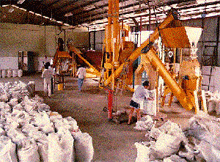
Fishmeal prices fell below the USD 1 000/tonne mark in February 2009 after two years of high prices. Since then they have recovered somewhat. The impact of the present economic situation on the fishmeal industry is still to be seen. Demand in China is expected to decline, as the Chinese pork industry is suffering from lower sales and depressed prices, which will reduce interest in fishmeal purchases by feed purchasers.
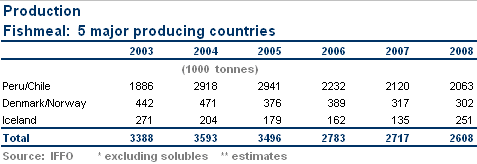
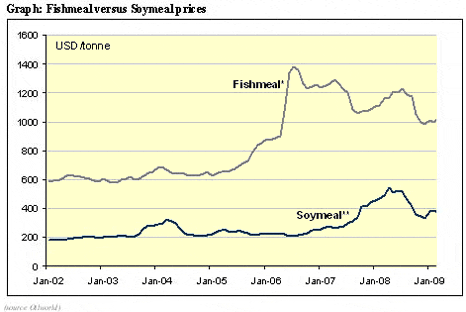
Peru export boom
Despite lower production, Peru managed to export more fishmeal in 2008. This was mainly because the country managed to reduce inventories created in 2007 as a result of sky high prices and consumer resistance. Total Peruvian fishmeal exports reached 1.56 million tonnes last year, 24 per cent ahead of the 2007 result. Main importing country continued to be China with a 53 per cent share of Peruvian exports of fishmeal. Germany is a distant second, importing some 190 000 tonnes of fishmeal in 2008. However, while Peru export figure show an increase, German import statistics register a decline; this might be explained by the retention of fishmeal in bonded warehouses, a common practice.
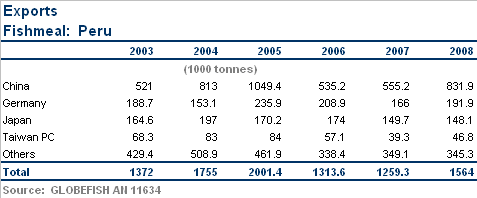
At present, most of the fishmeal business in Peru is betting on the new fishing season as remaining stocks from the last fishing season are very small. It is expected that the total fishing for reduction purposes in Peru during 2009 will be 6.5 million tonnes, a 6 per cent increase over the 6.1 million tonnes caught in 2008. The landings are expected to be 5.5 million tonnes in the northern part of the country, and 1 million tonnes in the south. The increase in quotas is coming from reportedly higher biomass of anchovies, estimated at 7.6 million tonnes in the north, some 1.5 million tonnes more than the biomass in late September 2008. The newly introduced individual quota system is also helping the fisheries to become more sustainable, and avoids the traditional rush in the first hours of the opening of the global catch quotas, as experienced in recent years.
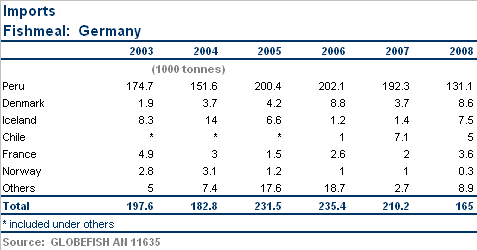
German imports of fishmeal were down in 2008, as prices were considered too high, and the feed producing industry turned to different raw material. Peru continues to be the main exported to the German market with over 80 per cent market share.
The impact of the economic crisis on Chinese consumers is starting to be felt. As industrial complexes in the southern part of the country start to close down, the migrant workers are moving back to their home villages. Pork consumption is declining as a result, leading to falling prices. The swine flu also influence the Chinese consumers negatively, and pork prices in China are in free fall. The situation has led the government to consider curbing pork imports, increasing exports and providing subsidies to farmers and meat processors. At present, demand for fishmeal for feed to the pork weaning industry is declining.
Less demand for fishmeal in future months?
Developments in the fishmeal industry in the coming months are very difficult to foresee: it is likely that demand will decline, especially in China, as a reaction to the worldwide economic crisis and the swine flu. At the moment, however, prices are moving upward after the negative trend in the closing months of 2008, based on limited availability and downward expectations for future fishmeal production.
May 2009



